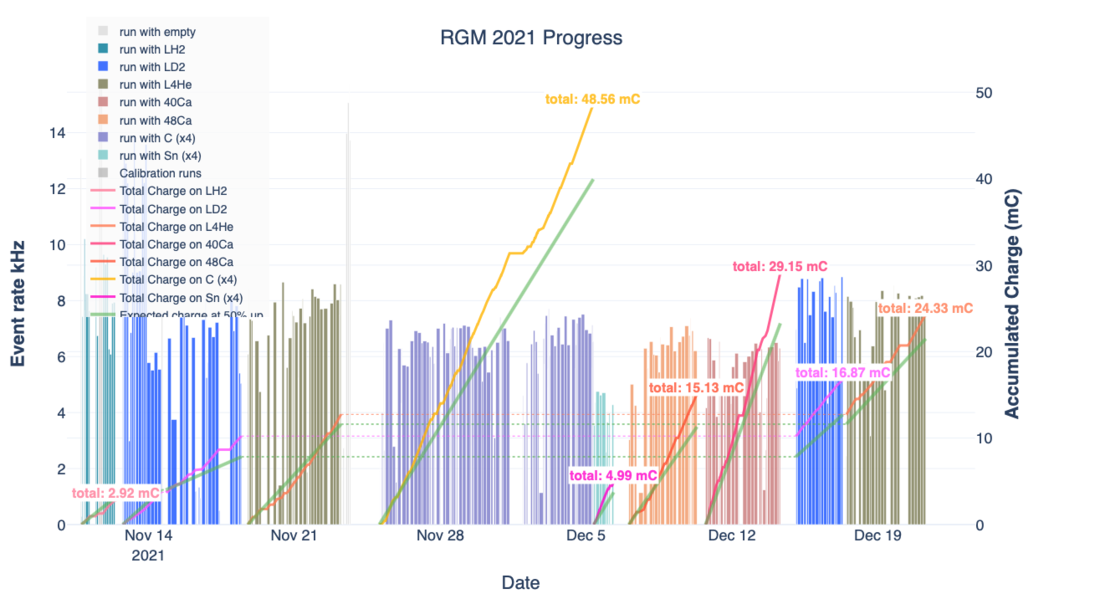Difference between revisions of "Run Group M"
| Line 233: | Line 233: | ||
* Do a '''RICH recovery''' (press the RICH Recovery button on the GUI) once daily during day shift, between runs. Please log in shift summary. | * Do a '''RICH recovery''' (press the RICH Recovery button on the GUI) once daily during day shift, between runs. Please log in shift summary. | ||
| − | ** | + | ** Note the automated "RICH Recovery" sequence already confirms RICH4 is up and accepting ssh connections before claiming success. And it also prints out that you have to "Cancel->Reset->Configure->Download->Prestart" before starting the next run. |
* '''[https://bta.acc.jlab.org Fill out BTA]''' hourly. Click "Load from EPICS" to automatically fill the left side then correct as needed. | * '''[https://bta.acc.jlab.org Fill out BTA]''' hourly. Click "Load from EPICS" to automatically fill the left side then correct as needed. | ||
Revision as of 15:15, 1 February 2022
- Shift Documentation
- Phone Numbers
- Short Term Schedule
- Notes/Known Issues
- Shift Expert
- Remote Worker Shift
- Monitoring
- Useful Links
Shift ScheduleESAD, COO, RSADShift ChecklistHot CheckoutBeam Time Accounting
|
Manuals |
Procedures |
JLab Logbooks
|
If calling local numbers (with area code prefix 757) from the counting room dial 9+[last 7 digits]. To call other area codes dial 91+[ten digit number]
|
| |||||||||||||||||||||||||||||||||||||||||||||||||||||||||||||||||||||||||||||||||||||||||||||||
- Note, all non-JLab numbers must be dialed with an area code. When calling from a counting-house landline, dial "9" first.
- To call JLab phones from outside the lab, all 4-digit numbers must be preceded by 757-269
- Click Here to edit Phone Numbers. Note, you then also have to edit the current page to force a refresh.
Click Here to edit Phone Numbers. Note, you then also have to edit the current page to force a refresh.
CLAS12 Run Group M, Fall 2021
Beam energies: 2.1, 4.0, 6.0 GeV (1.96 GeV/pass)
RC: Susan Schadmand and Sebastian Kuhn
- Susan Schadmand (757) 575-7540, susansch@jlab.org
- Sebastian Kuhn (757) 639-6640, kuhn@jlab.org
- 9 575 7540 from Counting Room
PDL: Valery Kubarovsky
- (757) 876-1789
- 9 876-1789 from Counting Room
- vpk@jlab.org
Run Plan: Jan 31, 2022
Production runs use PROD67_noVTPread and the trigger rgm_6GeV_inb_v1_0.trg .
Run duration 100M events or 4 hours, whichever comes first.
- status: 6GeV beam, LAr target is full, Beam blocker is OUT
- Note to self: Presently, the alarm limit for the beam_stopper_alarm is raised for running without beam blocker .
- Needs to be restored to 'normal' value for the solid targets where we need to run with the beam blocker IN.
- running: 25nA LAr for 2 days
- next:
- single tin foil for 2 days, beam blocker IN
- Ca48 target, beam blocker IN
DAQ configuration
PROD67_noVTPread , production trigger rgm_6GeV_inb_v1_0.trg .
NOTE: UNLESS a RICH problem crashes the DAQ, do NOT interrupt an otherwise smooth run to do a RICH recovery - instead do this in between runs.
NOTE: BOTH the shift expert AND the shift worker MUST check monitoring histograms at least once every 30-60 minutes to make sure there are no major detector problems.
At the end of each run, follow the STANDARD DAQ RESTART SEQUENCE
- "end run", if the run ended correctly then: "prestart", "go"
- if the run did not end correctly or if any ROCs had to be rebooted:
- "cancel", "reset"
- "configure", "download", "prestart", "go"
- After each step, make sure it is completed in the Run Control message window. If a ROC has crashed, find which one it is, issue a roc_reboot command ON JUST THAT ROC and try again. Contact the DAQ expert if there are any questions.
References and Standards
(last update 01/18/2022- 23:30)
Nominal Beam Positions
- 2H01, X: -0.6 mm, Y: 0.8 mm
- 2C24, X: -2.0 mm, Y: +0.6 mm
FSD Thresholds
- Upstream: 2000 Hz
- Midstream: 2000 Hz
- Downstream: 500000 Hz
- BOM: 10000
- 5 ms dwell time
Reference Harp Scans for Beam on Faraday Cup: 2H01 [1]
Reference Harp Scans for Beam on Tagger dump: 2C21 [2], tagger harp [3]
Reference Monitoring Histograms (6 nA, production C) [4] Old reference Monitoring Histograms (50 nA, production LD2) [5]
Counter rates
- Upstream counters integrated rates: 0-15 Hz (acceptable up to 100 Hz are acceptable) @50 nA.
- Midstream counters: 10-20 Hz (acceptable up to 50 Hz) @50 nA.
- Counting rates of ~ hundreds of Hz may indicate bad beam tune or bleed-through from other Halls.
Beamline vacuum: should be not higher than 5e-5.
NOTE: BOTH the shift expert AND the shift worker MUST check monitoring histograms (mon12) at least once every 30-60 minutes to make sure there are no major detector problems.
Notes
|
Known Issues
|
|
NOTE: BOTH the shift expert AND the shift worker MUST check monitoring histograms at least once every 30 - 60 minutes to make sure there are no major detector problems.
(remote) shift worker: see dedicated Remote Shifts tab above. |
|
TasksEvery Run:
Every Shift:
Regularly:
|
| ||||||||||||||||||
Webcams
|
Manuals |
Hall Webcams |
Epics on the web
|
Live Monitoring Links
|
|
|
Hall-B
Run lists |
AcceleratorReferences |
ZOOM meetings
|

